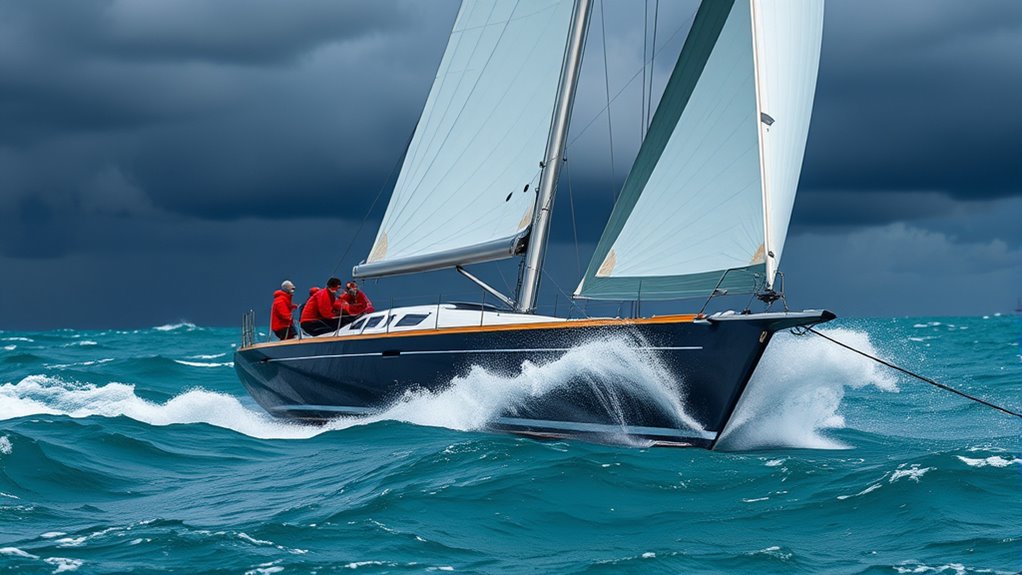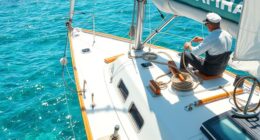When sailing in strong winds, assess wind conditions carefully by observing water, clouds, and using anemometers. Reef early, tightening reefing lines evenly to reduce sail area without distorting shape, and adjust sail trim often for control. Steer smoothly and slightly off the wind to prevent jibes, shifting crew weight and boat balance as needed. Prioritize safety by wearing gear, keeping alerts, and knowing emergency signals. Continue exploring these techniques to handle heavy weather confidently.
Key Takeaways
- Reef early by reducing sail area at the first sign of strong gusts to maintain control and prevent damage.
- Adjust sail trim and tension carefully, tightening sheets and reef points for better responsiveness in high winds.
- Steer slightly off the wind to avoid accidental jibes and enhance stability during gusty conditions.
- Shift crew weight inward and forward to counter heel and improve boat balance in strong winds.
- Maintain smooth, deliberate steering and proactive course adjustments to navigate safely through turbulent conditions.
Recognizing and Assessing Wind Conditions

Understanding wind conditions is essential for safe and effective sailing in strong winds. Before you set sail, take note of the wind’s speed and direction. Feel the wind on your face and observe how the water reacts; choppy waves and whitecaps indicate increasing strength. Use your boat’s instruments or a handheld anemometer to get precise measurements, especially in gusty conditions. Watch for changes in wind patterns throughout your journey, as shifts can quickly impact your safety. Pay attention to cloud formations—dark, towering clouds often signal stronger gusts. Recognizing these signs helps you anticipate what’s ahead, allowing you to prepare or adjust your course early. Accurate assessment of wind conditions keeps you in control and minimizes risks during strong-wind sailing. Additionally, understanding the contrast ratio of your boat’s sails—or the visual impact of wind strength on your environment—can assist in making more informed decisions during your voyage. Being aware of automation technologies used in modern sailing equipment can further enhance your ability to respond swiftly to changing conditions. Regularly consulting wind forecasts and real-time data can also improve your situational awareness, helping you stay ahead of sudden weather shifts. Moreover, knowing how to interpret wind turbulence can help you better gauge the stability of the airflow around your vessel. Recognizing the importance of sail trim adjustments can optimize your boat’s performance in various wind conditions.
Reefing Strategies for Heavy Weather

When the wind intensifies and the seas turn rough, reefing becomes an essential technique to maintain control and safety. To reef effectively, identify the appropriate reef point early—usually the first or second reef—before conditions worsen. Ease the mainsail halyard and lower the sail carefully, ensuring it’s properly secured once reefed. Tighten the reefing lines evenly to reduce sail area without distorting the sail shape. Keep a firm grip on the helm to steer into the waves and prevent accidental jibes. Reefing reduces sail power, stabilizing the boat and making it easier to handle in heavy weather. Always communicate clearly with your crew during the process, and double-check all reefing lines and sail attachments before continuing your course. Proper reefing also involves understanding how advanced control systems can assist in optimizing sail trim during challenging conditions. Incorporating modern sailing technology can improve safety and efficiency when reefing in heavy weather. Being familiar with sail management techniques can further enhance your ability to respond swiftly and effectively.
Proper Sails and Rigging Adjustments

To handle strong winds effectively, you need to adjust your sails and rigging properly. You’ll want to fine-tune your sail trim and reefing techniques to maintain control. Making these adjustments promptly can make a big difference in staying safe and efficient on the water. Proper equipment maintenance ensures your gear performs reliably when you need it most. Additionally, understanding how to adjust rigging can help prevent damage and improve responsiveness during challenging conditions. Regular inspections and maintenance of your sails and rigging are essential for optimal performance in high wind situations, especially considering the importance of equipment durability. Monitoring weather conditions can also help you anticipate changes in wind strength and adjust your sails proactively.
Reefing Strategies for Wind
As winds pick up, adjusting your sails and rigging becomes essential to maintain control and safety. Reefing is your main strategy to reduce sail area and prevent overpowering. Start by easing the main sheet to depower the sail, then loosen the halyard to lower the sail’s height. Secure the reefing points, which are reinforced sections of the sail, to the reefing tack and clew to take in excess fabric. Make sure the reefing luff and reef points are tight to prevent flapping. Check that the reefing lines are clear and properly led to your winches. Always do reefing gradually, and ensure the sails are evenly reefed for balanced handling. Proper reefing keeps your boat stable and responsive in strong winds. Additionally, understanding potential pitfalls in adopting new payment technologies can help ensure your sailing equipment and systems remain secure and reliable under challenging conditions. Being aware of remote collaboration tools can also assist in coordinating maintenance or repairs when sailing in remote areas. Ensuring your rigging hardware is inspected regularly can prevent failures during critical moments in strong winds.
Adjusting Sail Trim
Proper sail trim guarantees you maintain control and optimize boat performance in strong winds. You need to fine-tune your sails to handle the increased power and stay responsive. Focus on easing the sheets to depower the sails, reducing heel and maintaining balance. Adjust the tension in the jib and main halyards to keep sails flat and efficient. Pay attention to the traveler and boom position, allowing for precise angle control. Keep sails flat by tightening the sheet and halyard lines. Use the traveler to angle the boom properly for wind conditions. Ease or trim sheets quickly to respond to gusts and lulls. Monitoring sail tension ensures sails stay effective and responsive during heavy winds. Incorporating the appropriate tip size for your sails can also improve control and finish quality during adjustments. Properly managing sail adjustments enhances control and safety in challenging conditions. Staying aware of local regulations can help you avoid penalties and ensure compliance while sailing in different regions. Additionally, understanding how navigational techniques influence your sail trim can lead to more precise handling in variable conditions. Mastering these adjustments helps you stay in command, prevents overpowering, and ensures a smoother ride even in heavy winds. Proper sail trim makes all the difference between sailing safely and losing control.
Steering Techniques for Stability and Control

When sailing in strong winds, maintaining stability and control requires precise steering techniques. You should keep a firm grip on the wheel or tiller, making small, deliberate adjustments to counteract gusts. To prevent sudden jibes, steer slightly off the wind and avoid abrupt turns that could destabilize the boat. Use gentle, continuous steering inputs rather than quick corrections. Focus on maintaining a steady course, especially when waves push against your boat. Keep your body balanced and centered to respond quickly to changes in wind and water. If you notice the boat starting to heel excessively, ease the sails slightly and steer to reduce the angle of heel. Consistent, smooth steering helps you stay in control and guarantees safety in challenging conditions. Proper sail trim is also essential to optimize performance and stability during strong winds. Additionally, being aware of weather conditions helps anticipate sudden changes and adjust your steering accordingly.
Handling and Tacking in Strong Winds

Handling and tacking in strong winds requires careful timing and precise boat control. You need to stay alert and anticipate each move, adjusting your sails and steering smoothly. To succeed, focus on these key points:
Master tacking in strong winds with smooth, coordinated maneuvers and keen anticipation.
- Plan your tack early to avoid sudden moves that can cause loss of control.
- Use gentle, coordinated maneuvers to keep the boat steady through the turn.
- Maintain momentum by trimming sails correctly and avoiding over-steering.
Speed up slightly before the tack and ease the sheets to reduce strain. As you approach the wind, steer smoothly into the new course and swiftly trim your sails. Staying calm and precise minimizes the risk of capsizing or losing control in challenging conditions. Practice these techniques to improve your handling in strong winds.
Balancing the Boat for Optimal Performance

Achieving ideal performance while sailing depends heavily on how well you balance the boat. Proper trimming and weight distribution help keep the boat stable and maximize speed. Shift your weight slightly forward or aft based on wind conditions to prevent excessive heeling or sluggishness. Use the following table to fine-tune your balance:
| Wind Condition | Crew Position | Sail Trim |
|---|---|---|
| Strong, gusty winds | Move crew weight slightly forward | Tighten main sheet for control |
| Steady moderate winds | Keep weight centered | Adjust sails for optimal shape |
| Light winds | Shift weight aft | Ease sails to catch more wind |
| Wind shifts frequently | Rebalance crew quickly | Re-trim sails accordingly |
| Excessive heeling | Move crew weight inward | Reduce sail area or loosen sheets |
Navigational Considerations in Windy Conditions

Navigating in windy conditions requires careful attention to your course and situational awareness. Strong winds can push you off course quickly, so stay alert to changes in wind direction and strength. Adjust your sails early to maintain control and avoid sudden jibes or capsizes. Keep an eye on your surroundings, including nearby boats and obstacles, to prevent collisions.
Consider these key points:
- Continuously monitor wind shifts and adjust your heading accordingly
- Use visual cues like cloud movement or wave patterns for better wind prediction
- Maintain a safe distance from shoreline and other vessels to avoid hazards
Safety Precautions and Emergency Procedures

You need to be prepared for emergencies by knowing the proper signal protocols and having your safety gear ready. Make sure you understand the emergency signals and how to use them to alert others quickly. Always wear your personal safety equipment and double-check that it’s in good condition before heading out in strong winds.
Emergency Signal Protocols
When strong winds threaten safety, knowing and promptly executing emergency signal protocols can make all the difference. Your quick response can alert others and ensure help arrives swiftly. Familiarize yourself with common signals such as foghorn blasts, visual distress signals, or emergency flares.
Here’s what you should do:
- Use your vessel’s horn or whistle to sound distress signals, like repeated blasts.
- Display visual signals, such as bright flags or flashing lights, to attract attention.
- Deploy flares or other pyrotechnic devices in clear view of nearby boats or rescue teams.
Always confirm your signals are clear and consistent. Regularly practice these protocols so you can act swiftly if a situation arises. Clear communication can save lives and prevent escalation during emergencies.
Personal Safety Equipment
Equipping yourself with the right personal safety gear is essential for staying protected during strong winds and rough seas. Always wear a life jacket tailored to your size and activity, ensuring it’s properly secured. A safety harness with a lanyard keeps you attached to the boat, preventing accidental falls overboard. Carry a whistle or signaling device to attract attention if needed. Wear non-slip footwear to maintain footing on wet surfaces. Bring a waterproof, quick-drying jacket to protect against the elements, and keep a personal flashlight handy for emergencies. Don’t forget a waterproof bag with a first aid kit, and always have a marine radio nearby for communication. Proper safety equipment minimizes risks and prepares you for emergency procedures in challenging conditions.
Post-Sailing Checks and Maintenance

After sailing in strong winds, it’s essential to thoroughly inspect your boat to guarantee everything remains in ideal condition. Check for any damage caused by the rough conditions, such as torn sails or loose fittings. Inspect the rigging and lines for wear or fraying, ensuring they’re secure. Also, examine the hull for cracks or dents that might have occurred during the sail.
Here are key maintenance tasks to focus on:
- Clean and rinse all deck equipment to remove salt and debris
- Lubricate moving parts like winches and sheaves
- Check and tighten all bolts, nuts, and fittings
Completing these steps helps prevent issues on your next sail and extends your boat’s lifespan. Regular post-sailing maintenance keeps you safe and ready for your next adventure.
Frequently Asked Questions
How Can I Predict Sudden Wind Gusts While Sailing?
To predict sudden wind gusts while sailing, pay close attention to weather patterns and cloud formations. Keep an eye on the sky for dark, towering clouds, and notice changes in wind direction or speed. Listen for sounds like whistling or howling, which often indicate gusts. Stay alert to the water’s surface, looking for choppy waves or whitecaps. These signs can help you prepare for unexpected gusts before they catch you off guard.
What Materials Are Best for Sails in High Wind Conditions?
When selecting materials for sails in high wind conditions, you want durability, strength, and control. You should opt for high-performance woven fabrics like Dacron or laminate materials such as Mylar for their resilience and lightness. These materials resist stretching, handle gusts well, and maintain shape. You need fabrics that balance stiffness and flexibility, ensuring your sails stay responsive without risking damage during gusty, challenging winds.
How Do Different Boat Designs Affect Wind Handling?
Different boat designs markedly influence how you handle strong winds. You’ll find that narrower hulls cut through the wind more efficiently, providing better control. Skeg or keel designs help stabilize your boat, making it easier to manage high winds. A taller mast can catch more wind, which might be challenging unless your sails are designed for such conditions. Overall, choosing a boat with a balanced, streamlined design enhances your ability to sail confidently in strong winds.
Can Specific Clothing Improve Safety in Strong Winds?
Wearing the right clothing can substantially boost your safety in strong winds. You should opt for a waterproof, windproof jacket to stay dry and protected, along with non-slip footwear for stability. A life jacket is essential, and layers help regulate your body temperature. Gloves and a hat can also improve grip and comfort. Proper clothing keeps you alert and secure, making your sailing experience safer in challenging conditions.
What Are Expert Tips for Navigating Tight Spaces in High Winds?
When maneuvering tight spaces in high winds, you need to stay alert and plan your moves carefully. Keep your boat’s speed steady, avoid sudden turns, and use your sails to control your momentum. Communicate clearly with your crew, and stay aware of your surroundings. Trust your skills, stay calm, and make precise adjustments. With focus and proper technique, you’ll handle tight spots safely even in challenging conditions.
Conclusion
Mastering strong winds is like riding a wild horse—you need confidence, quick thinking, and respect for its power. I once watched a sailor skillfully reef during a storm, turning chaos into control. With proper techniques, you can tame the wind’s fury and enjoy the thrill of sailing even in heavy weather. Remember, safety and preparation are your best tools—so face the wind head-on and sail with confidence.









